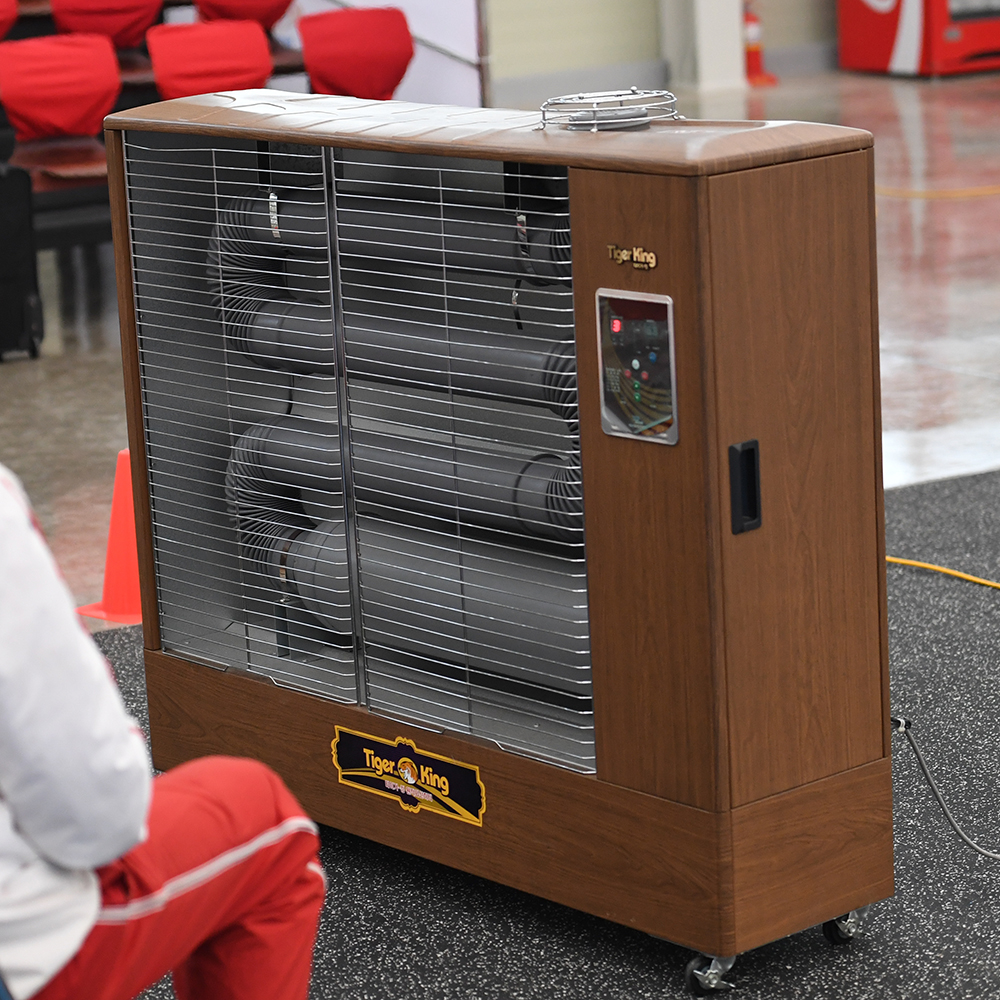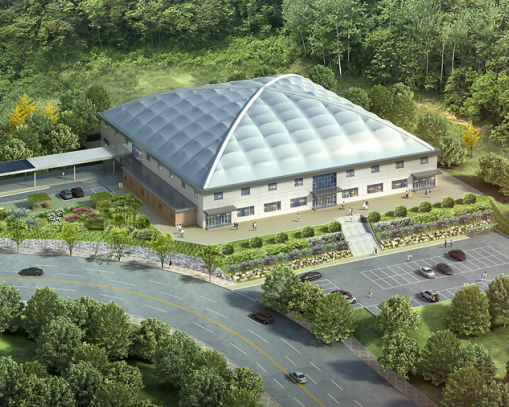Daegu’s main arena called heavenly, but ‘Stadium B’ not so hot
One observer says athletes would gather around the space heaters like they were on a Boy Scout camping trip âand then run to do their jumps before huddling around the heating units again. The temperature was often colder in Stadium B than it was outside, where temps were around 37 degrees F or so.â
Moreover: âWhen athletes would complain to officials about the cold, they were told that everyone was competing under the same conditions so it was fair.â
USATF national masters chairman Rex Harvey responded to my queries thusly:
The IAAF rule for indoor stadiums (which WMA follows) reads: âThe stadium shall be completely enclosed and covered. Lighting, heating and ventilation shall be provided to give satisfactory conditions for competition.â But âsatisfactoryâ is in the eye of the beholder. I am reasonably sure that had this been an outdoor meet, that, with no wind and rain, the temperature would not have been complained about at all.
However, like you, I did hear many complaints about the temperature in Stadium B, mostly repeatedly from one person, but several have told me that it was not ideal. However, it was not âvery coldâ as some people seem to be reporting to you.
Being the WMA Competition Team member in charge of Combined Events, I spent most of my time in Stadium B where most of the Pentathlon events were held and where I was also assigned on most non-Combined Event days.
I never had on any more than a thin T-shirt and the official long-sleeved shirt and a light wind breaker jacket and baseball cap. Being originally from Iowa, I would not call that âvery coldâ even though I live in Arizona now and have become somewhat thin skinned.
Because of my duty assignments, I could not attend all of the Team Manager meetings, but I assume the subject was apparently noted by the WMA Competition Team and/or the LOC, or came up from team managers early on as I did note that, by the second day of field events, the LOC had procured some small kerosene space heaters in Stadium B, and that by the third day there were several large (4 foot by 4 foot) kerosene space heaters in the stadium at the field event venues in addition to the smaller heaters.
These larger heaters were primarily positioned where the athletes were sitting for each event. I did note that some, who complained the most about the temperature, chose to sit off in the corner away from where the heaters were for some unknown reason(s).
The purpose of Stadium B is inherently obvious when you note what events were held there.
Obviously the events in Stadium B were those events that could not be held in Stadium A because of the configuration of that stadium and obviously those events that could not be held in Stadium A because the venues in Stadium A were already fully utilized.
I think it is pretty amazing that Daegu, upon attending the WMA Indoor Championships in Hungary, realized that all the indoor field events could not be conducted in one stadium, so they built another one. How many places in the world could and would have the means to do something like that on the spur of the moment?
It was originally planned to be immediately adjacent to the main stadium, but a small cemetery was there, forcing it to be built about 250 meters away, which I covered many, many times walking over 11 miles a day on the two Combined Events days as reported on my trusty Fitbit. It was not designed for and was never meant to be heated.
Overall, I heard it said many times, from all levels, that Daegu was the best WMA Indoor Championship ever held and I cannot disagree having planned, attended, participated, officiated and administered at some level or another at all of the WMA Indoor Championships except Hungary since the first one in Sindelfingen. Could some things have been better? Of course, and I think that will always be true wherever they may be held.
Aside from the conditions of Stadium B, Mathews said, âWeights and measures were not conducted properly, so no one could set a record with any of the implements.â
And one Daegu-goer said: âThere was a tremendously high rate of âno showsâ from the Korean team,â supposedly because a very popular Korean singing group was performing at Opening Ceremonies, âand it was cheaper to register for the WMAC and see the group perform on opening night than to buy a ticket to see the group at a regular venue. So after seeing their idols, about 30 percent of Korean athletes disappeared.â
Iâm checking with the LOC on this contention â as well as the cold in Stadium B.
What was YOUR experience in the cold? Did it hurt your performance?







7 Responses
I didn’t compete in stadium B but used it for my warmup for the 60m on the Monday. I did notice when I left that it was warmer outside, but it wasn’t too cold for warming up. I was grateful for that covered extension to the straight as part of the straight inside stadium B had to be cordoned off as competitors in the weight throw were managing to hook throws over the netting. My main reservation about that covered extension was it would not protect against horizontal wind and rain like you get in the UK.
I officiated in Stadium B for 5 of the 6 competition days it was in use. Monday, the first day was the worst. There was no heat and it was cold. On Tuesday they brought in some heaters for the athletes. By Wednesday there was heat for athletes and officials. Thursday, Friday & Saturday was the same. There was heat available for those who wanted it. It was cold inside, especially for the 9:00AM start times. It would warm up significantly for the afternoon start times. Stadium B was about 200M from main Stadium A and it was an uphill walk the entire way. The short walk was not difficult. Stadium B was a state of the art facility and they could easily add HVAC in the future. There was some dissension and complaining from a few athletes and it came from those with substandard performances. None of the record setters seem to mind the conditions.
Despite my raves for the meet as noted above, I did notice the cold in Stadium B and heard many complaints about it while I was photographing there, even from some officials.
While the size of the wonderful Stadium A could not accommodate all field events (thereby necessitating the construction of Stadium B), I think Stadium A could have accommodated more field events than it did.
For example, if one looks at the schedule, on Saturday, March 25, only one field event (M45 TJ) was staged in Stadium A. The other events held in Stadium A that day were the 400m finals, 1500m finals, and relays…all of which I missed photographing because I wanted to photograph the High Jump competitions that were going on at the same time in Stadium B.
The High Jump competitions could have easily been held in Stadium A that day, cutting down on some of the coldness complaints, because the field in Stadium A was virtually empty that day.
On another day I was shooting in Stadium A, I heard the announcer actually apologize to the audience for the lack of field events and invite them to trek up the hill to Stadium B if they wished to see some field events.
Thus, while it is laudatory that the Koreans built Stadium B for certain field events, I think Stadium A could have accommodated more field events than were staged there and then maybe fewer athletes would have complained about the cold in Stadium B.
I competed in both the W45 LJ at 16.30 in the afternoon and W45 SP at 09.00 both at Stadium B. Personally I found the Temperature of the stadium comfortable for competition. in fact in the LJ I had to position myself away from the heaters because it was making me too hot.
I would like to say the LOC put on a brilliant show and I think the best championship I have attended in masters athletics. The only downside was the non declaration for events which meant many 60m races with only two or three athletes due to the huge Korean drop out and the WMA council not implementing a declaration process this was not the fault of the LOC. Also some interesting timetabling of events that seemed to accommodate certain athletes particularly the person who designed it.
Throws guru Jerry Bookin-Weiner writes me:
The temperature in Stadium B was heavily dependent on the time of day. At 8 am it was a lot colder than later in the day and by noon it had warmed up considerably each day and was quite comfortable.
I would also say that the logistics of the meet were absolutely first class with hundreds of volunteers staffing stations at the main train station (and I presume at the airport as well though I was never there), each of the shuttle bus stops, and all over the venues.
Those volunteers, many of whom spoke English, were unfailingly helpful, including helping athletes carry their luggage to buses and walking with them if they looked lost.
Indeed, if they saw someone at the train station who looked like an athlete they proactively approached them and asked if they needed assistance. This was my first indoor WMA Championships, and from what I saw Daegu set a standard that it will be hard for Torun and other future sites to meet.
I second Jerry’s remarks about the helpfulness and politeness of the volunteers and the Korean people in general.
One particularly touching gesture was a large contingent of Korean women in the stands of Stadium A with noise makers who would cheer and make noise no matter what nation won a race.
OK, I guess I’m a wuss. Too much time in Arizona this winter. Slight medical problem was going on during competition for me. My bad, all good.
Leave a Reply